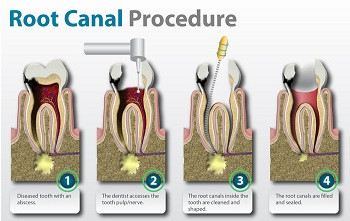Root Canal
It is possible to save your tooth & smile! Root canal treatment is done for retrieve-infected teeth permanently. Root canal treatment is a dental procedure where the infected or damaged pulp of a tooth is removed and the inside areas are filled and sealed. Little or no discomfort is there and the procedure is performed in either single visit or multi visits. Root canal treatment saves the teeth that would otherwise need to be extracted. The most common cause of pulp infection is a cracked tooth or a deep cavity. They let in bacteria to the pulp and cause infection inside the tooth. If not treated, pus builds up at the root tip in the jawbone forming a “pus-pocket” called an abscess, which can cause damage to the bone around the teeth.
The most common causes of pulp damage or death are:
- A cracked tooth
- A deep cavity
- An injury to a tooth, such as a severe knock to the tooth, either recent or in the past.
When this occurs your tooth can often still be saved with root canal therapy. Severe pain, swelling, sensitivity to hot or cold, or a darkening tooth, are signs that a root canal problem exists. The purpose of root canal therapy is to eliminate tooth pain. If untreated infected pulpal tissue is left, pus can build up at the root tip in the jawbone, forming an abscess. An abscess can destroy the bone surrounding the tooth and cause severe pain. Root Canal Treatment is, cleaning the tooth and removing the infection, which is causing the pain. The cleaned tooth is then protected from further infection by treating them with a solution and inserting fillings.
During a root canal procedure, the dentist will remove infected blood vessels, tissues and nerves from the tooth, irrigate the pulp canal to get rid of the contamination and then fill up the root canals with an inert material. The tooth is then shaped so that a crown can be fixed over it. As a result, the tooth is reinforced and looks natural.
Process of Root Canal

Root canal treatment consists of several steps that take place over several office visits or sometimes it may be completed in a single sitting, depending on the situation. These steps are:
- First, the dentist will give you local anesthesia—this means an injection near the bad tooth. Then he proceeds to drill away the top part of the infected tooth to expose what is called the “pulp” of the tooth. The pulp is a bunch of tissues, nerves, arteries and veins that connect your tooth to your jaw bone. This is the part that bacteria have eaten away and damaged, causing you toothache.
- An opening is made through the tooth and the diseased pulp is removed (Pulpectomy). After pulpectomy, the pulp chamber and root canals are cleaned, enlarged and shaped in preparation for being filled.
- If more than one visit is needed, a temporary filling is placed in the crown opening to protect the tooth between dental visits.
- A tapered, rubbery inert material called gutta-percha is inserted into each of the canals and is often sealed into place with cement. Sometimes a metal or plastic rod (post) is placed in the canal for structural support. If the tooth is very broken down, a post may be required to build it up prior to placing a crown.
- In the final step, a crown is usually placed over the tooth to restore its natural shape and appearance.
Your treated and restored tooth/teeth can last a lifetime with proper care. Because tooth decay can still occur in treated teeth, good oral hygiene and regular dental exams are necessary to prevent further problems.
As there is no longer a pulp keeping the tooth alive, root-treated teeth can become brittle and are more prone to fracture. This is an important consideration while deciding whether to crown or fill a tooth after root canal treatment.
To determine the success or failure of root canal treatment, the most relied-upon method is to compare new X-rays with those taken prior to treatment. This comparison will show whether bone continues to be lost or is being regenerated.
After the Treatment, you may have some pain, soreness or swelling for a day or two after the procedure. The dentist may decide to prescribe you painkillers and antibiotics to help in recovery. Most people can resume normal routine within 24hours.
